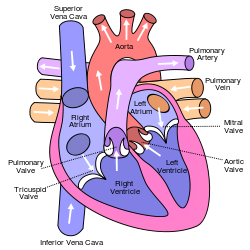Although blood circulation is one constant circle of flow, it consists of two subsystems: pulmonary and systemic circulation mediated by the heart. Within the systemic circulation there are other subsystems: coronary, portal (hepatic), and renal.
Deoxygenated blood comes into the right atrium of the heart. The blood coming from the body does so by way of the superior vena cava and the inferior vena cava. The blood coming from the heart does so by way of the coronary sinus, the anterior coronary veins, and the venae cordis minimae. Thus, the right atrium receives the blood return from the whole body, including the heart.
From the right atrium, the deoxygenated blood passes through the tricuspid valve (one of the two atrioventricular valves) into the right ventricle. Upon contraction of the right ventricle (ventricular systole) blood is propelled through the pulmonary (sometimes called pulmonic) valve into the pulmonary trunk. The pulmonary trunk divides into a right and a left pulmonary artery, each of which enter a lung, thus starting pulmonary circulation.
Within the lung the arteries divide until they form a minute capillary meshwork around the alveolar sacs. At this point the deoxygenated blood discharges its CO2 and gains O2, becoming oxygenated blood which converges back towards the heart by way of pulmonary veins.
The oxygenated blood enters the left atrium by way of the four pulmonary veins. It passes into the left ventricle through the mitral valve (also known as the bicuspid valve), then it exits through the aortic valve and into the aorta. This starts systemic circulation.
The aorta and its branches provide oxygenated blood to all the body. Once the blood is deoxygenated, it comes back to the right atrium of the heart where the cycle starts again.
As a side note, all the vessels that enter or leave the heart are known as the great vessels. How many are the great vessels? For the answer, click here.




